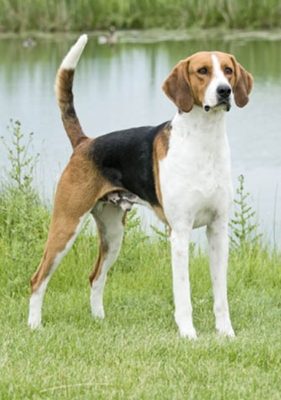English Foxhound
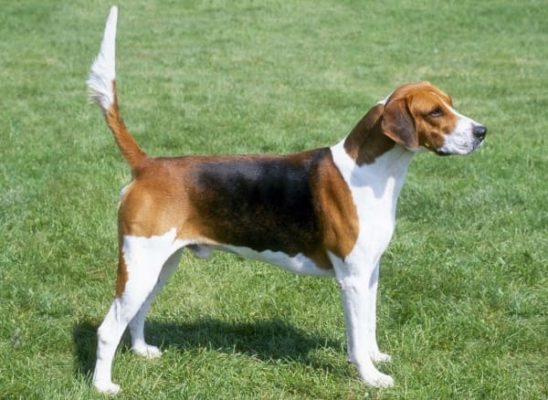
Experienced owners consider the Foxhound an excellent companion for any member of the family, including children. The English Foxhound is friendly and balanced. Very fond of outdoor activities and will gladly keep you company during jogging. Not bad also as a guard, to strangers are mistrusted. The main feature of the breed is considered a loud and resonant bark.
Table of Contents
Breed Information
| Another Name | Foxhound |
| Origin | Great Britain – England |
| Height | Males 58-64 cm Females 53-61 cm |
| Weight | 27-34 kg |
| Fur | Short |
| Color | White with black spots in blush, lemon-pie |
| Lifespan | 10-13 years |
| FCI Classification | Scent hounds and related breeds |
| Group | Hunting dogs |
| Price | From $400 |
Breed Photos
Origin History
The English Foxhound is considered to be England’s most famous hound. The breed’s name is directly related to the literal translation, which means “fox chaser”. Hence, there is a second name for the dog – the English foxhound. Celtic hounds, greyhounds, terriers, and even bulldogs participated in the formation of the breed.
It is still unknown exactly who brought the breed to the American continent. There are several versions: in 1650, the dogs were delivered by breeder and dog breeder Robert Brooke. And if you believe other sources, the English hound appeared in America in 1738 and was brought there by Lord Fairfax. At the same time, the breed was actively used to create other hounds (American Foxhound and Russian Hound). By the way, the American version of the Foxhound is now the official symbol of Virginia. By 1880, the popularity of the English Foxhound has grown very much – at this time in England, there were already about 7000 individuals of the breed. In 1905, the American Kennel Club recognized the breed, and in 1955 the English Foxhound was officially recognized by the Fédération Cynologique Internationale.
Appearance
The English Foxhound is a harmonious and powerful dog. Not a massive and strong skull. The head corresponds to the body, the transition from forehead to muzzle is moderate. Around the muzzle, there are “freckles” characteristic of the breed. The muzzle is square and long. The eyes are of medium size with a very attentive look. Hanging triangular ears (if cropped, the shape is closer to oval), pressed to the head. The neck is well developed, slightly curved. The back is strong and broad. The tail is planted high, at the back’s level (never laid on the back). The coat is dense and thick, short. The color is varied, most often lime-pedigree or white, occupying about a quarter of the body, with black spots, around which a bright red edging.
Character
Experienced owners consider the Foxhound an excellent companion for any member of the family, including children. The English Foxhound is friendly and balanced. Very fond of outdoor activities and will gladly keep you company during jogging. Not bad also as a guard, to strangers are mistrusted. The main feature of the breed is considered a loud and resonant bark. Therefore, it is often recommended to keep English Foxhound in a private home rather than in an apartment. Interestingly, the breed representatives have a poorly developed sense of smell, and when hunting, the Foxhound relies only on its accurate vision. With children, English Foxhound will be gentle and playful. They very quickly become attached to family members and hardly experience loneliness.
Care
The English Foxhound needs long walks and some physical activity, as it acts as an energetic dog with special needs. Grooming is not difficult; the Foxhound’s coat is short and quite stiff. Comb the pet once a week with a special brush to maintain a healthy look and coat condition. Molting is average and more seasonal (due to white coloration, the coat is just more visible). To prevent ear infections – carefully monitor and clean the ears several times a week. Also, check the eyes at least once a week. Bathe your pet as needed. Do not give him too many baths, as this may dry out his skin. Trim its nails a few times every two or three months.
Training
Treat the training sessions with patience and some necessary rigor because the English Foxhound is very curious and stubborn. His attention can be scattered to absolutely everything around him. Therefore, you should show the pet your authoritative position and achieve mutual respect from an early age. Do not be aggressive and prepare for the fact that everything will not work right away. Use imagination, playfulness, and encouragement. Don’t push the learning curve and skip training if you want to achieve command compliance and foster an obedient dog.
Common Diseases
Despite good health and a strong immune system, the English Foxhound is prone to some diseases:
- epilepsy;
- hypothyroidism;
- cardiomyopathy;
- hip dysplasia;
- deafness;
- kidney disease.
Nutrition
In food, the English Foxhound is unpretentious. The dog eats natural food well, but 1/3 of the diet should be meat. Also, veterinarians recommend selecting a balanced diet. For this purpose, a dry food of premium class is suitable, which will have the necessary norm of vitamins to form a healthy skeleton of the pet.
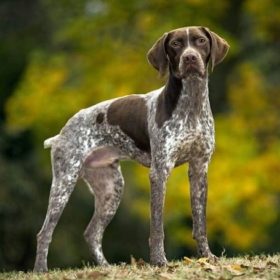 Braque Francais (Gascogne)
Braque Francais (Gascogne) Hygen Hound
Hygen Hound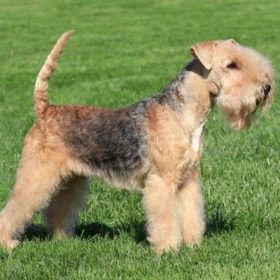 Lakeland Terrier
Lakeland Terrier Petit Bleu de Gascogne
Petit Bleu de Gascogne Giant Schnauzer
Giant Schnauzer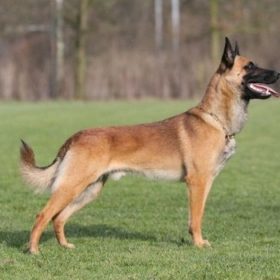 Belgian Shepherd Malinois
Belgian Shepherd Malinois
